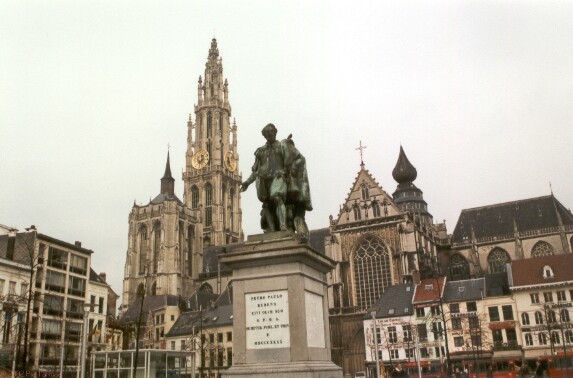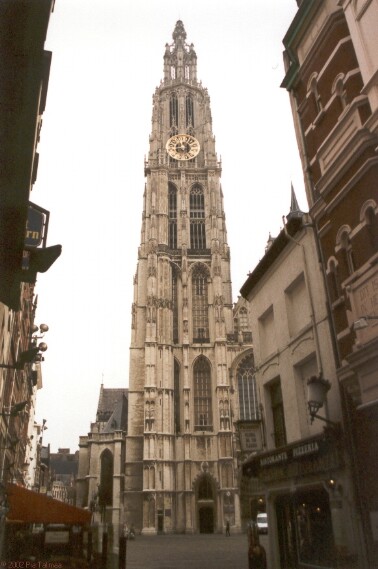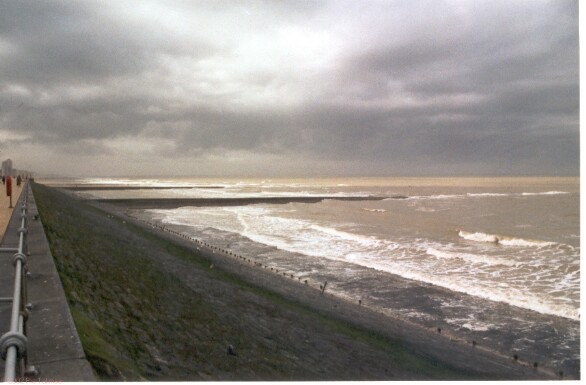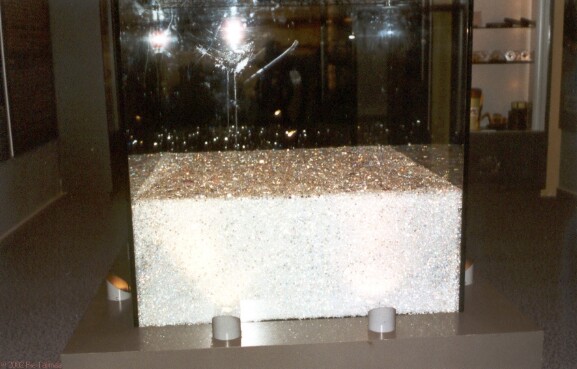|
|
|
| Antwerpen / Antwerp | |
|
Here are some pictures of our trip to Antwerp. |
|
 |
The cathedral seen from the Town Square Not as big as the 'Grand'Place' of Brussels, but certainly as beautiful is the 'Grote Markt' (= Town Square) of Antwerp. Here is still the heart of the old city. The Grote Markt is beautifully surrounded by the Town Hall and the so-called houses of the Guilds or corporations. In the background the tower of Our Lady's Cathedral completes the magnificent view. The houses of the Guilds are unfortunately not the original ones. A large part of the Grote Markt burned down in 1576. Most of the houses were rebuilt afterwards by Hans Vredeman, the town architect, in Flemish Renaissance style. In the 19th century the houses were again renovated. The house number 7 is one of the most beautiful. It was the house of the guild of Archers and is crowned by the statue of St. George. The house number 25 , a reconstruction of a house that used to stand at the 'Meir' is situated on the spot were an Inn used to stand. This Inn was mentioned in the medieval play of 'Marieken van Nieumwhegen'. Nowadays the Grote Markt is one of the most pleasant squares in the city (certainly since traffic has been banned from it). During beautiful warm summer days most people choose this spot to enjoy a refreshing beer from one of the many terraces. BRABO In the middle of the 'Grote Markt' stands the Brabo fountain. The statue was made by sculptor Jef Lambeaux in 1887. According to a legend, a terrible giant, called Druoon Antigoon, lived on the banks of the river Scheldt in ancient times. Whenever sailors on the Scheldt river refused to pay toll to the giant, he punished them by cutting off their hand. A Roman soldier, Silvius Brabo, managed to kill the giant. Brabo cut off the hand of the giant and threw the hand away in the river. Hence, according to the legend, the name of the city : hand ( Engl.: hand) -werpen (Engl.: to throw). A nice legend, but untrue. Nevertheless, the 'hand' is the symbol of Antwerp.There are hands in the town flag. Also there are several sweets in the form of a hand (cookies, chocolates). In any case, without the Brabo fountain, the Grote Markt would not be complete. Notice how the water of the fountain is not caught in a basin, but just simply disappears under the stones of the monument where it enters in a closed water circuit. |
 |
Statue of the famous painter P.P. Rubens
The town square 'Grote Markt' is the most beautiful square of the city of Antwerp as well as the historical heart of it. The most popular square, however, is certainly the 'Groenplaats' (= Green Square). The square used to be a parking lot. But recently, the parking has been built underground, and the Groenplaats is rapidly finding back its charm of old. On warm afternoons the square can be really packed with people (tourists as wells as Antwerpians) who all enjoy a good beer (or something else) on the numerous terraces. The Groenplaats is dominated by Our Lady's Cathedral. In medieval times the cemetery of the cathedral was located here. Around the square are numerous restaurants and cafés where many famous artists spent their time. In the middle of the Groenplaats the statue of Rubens can be seen. It was made in 1843 by sculptor Geefs. Very beautiful is the facade of the 'Karbonkelhuis' at number 33. This former 'diamond house' is an example of the Renaissance style. The name of the house is derived from the diamond head decoration at the ground floor. The right side of the square is dominated by the late 19th century imposing building of the Hilton Hotel. It used to be the 'Grand Bazar', one of the leading Belgian department stores. Behind the Hilton Hotel is now a pleasant and spacious covered shopping gallery. Much like in most other cities in Belgium, the contrast in architectural styles is not absent at the Groenplaats. The Gothic tower of the Cathedral finds a 20th century answer in the 'Boerentoren'. This tower is the seat of the Kredietbank, one of the important Belgian banks. It was built in 1930 in art deco style. It is 97 m high and is considered by most as the first 'skyscraper' in Europe. The Antwerpians call it the 'Boerentoren' (= farmers tower) because the farmers were the most important clients of the Kredietbank in the first half of the 20th century. |
 |
The 'Steen' ,old tollhouse and now maritime museum 'Steen' is the Dutch word for 'stone'. In Antwerp the 'Steen' is the name of the little castle that can be seen at the entrance of the city center, on the border of the river Scheldt. The castle is called that way because it was one of the earliest buildings in Antwerp constructed with stones (at a time when most houses were still built with wood). The name 'Steen' can be found in other cities too. It always refers to a castle-like fortification (e.g.: the castle of the counts of Flanders in the city of Gent is also called 'Graven-steen', or (stone) Castle of the Counts). The Antwerp Steen has been renovated numerous times. It was probably built as a part of the fortification around the city in the 13th century. In 1520, during the reign of Charles V, the castle was renovated by the architects Keldermans and De Waghemakere. The chapel which forms a loggia above the entrance dates from this period. It bears the motto of Charles V 'Plus Outre'. At the entrance a relief statue can be seen of a man with spread out legs. This statue also used to have a very large penis and was therefore venerated by numerous women looking for a cure against infertility. The Jesuits found the statue too obscene in the 17th century.... and off went the decoration of the statue ! The Steen was used as a prison from 1549 until 1823. As from 1862 it was used as the Archeological Museum. It was again renovated in 1889-1890 and a Neo-gothic wing was added to the building. Since 1952 The National Navigation Museum is housed here. Next to the castle are the large storage halls of the 19th century harbor. Here can be seen numerous vessels and boats which belong to the Maritime Museum. |
 |
Statue of 'Brabo' in front of Townhall
The eye-catcher of the 'Grote Markt' (town square) is, of course, the Town Hall of Antwerp. It is one of the oldest Renaissance buildings in the Low Countries. It was finished in 1564 by architect Cornelis Floris de Vriendt. Antwerp had made plans at the beginning of the 16th century to build a new town hall in Gothic style, much like the town halls of Leuven, Brussels and Oudenaarde. However, the Antwerpians had to use the construction material for their new town hall to defend themselves against attacks from the Army of Maarten van Rossem from Gelre. It was only twenty years later that the financial position of the city had improved to such an extent that the plan for a new building for the mayor was unshelved. But, by this time fashion had changed. The Gothic style was out and Renaissance style had become the new fashion The present town hall of 1564 shows that it has been built by a city at the height of its power and wealth. The style of the building is obviously Renaissance (the superposition of Dorian and Ionic colons), but the middle section still clearly resembles the towers of the many Gothic Flemish and Brabantine town halls. The 45 doors in the ground floor were built to house little shops. The rent that the shop-keepers had to pay was used to help finance the construction of the prestigious building. The middle section is decorated with the statues of Lady 'Justitia' and Lady 'Prudentia'. The weapons are those of the Duchy of Brabant (black field with gold lion), the coat of arms of the Spanish King Philip II (middle) and of the Markgrave of Antwerp (right). Above the weapons is a Madonna statue, which is obviously too big for the niche it stands in. It was put there by the Jesuits during the Counter-Reformation to replace a Brabo statue, considered to be too heathen during the troubled times of the religious wars at the end of the 16th century and the beginning of the 17th. The inside of the building is also certainly worth a visit. The interior decoration dates mostly from the 19th century. |

|
Entrance to the cathedral The chapel which stood here in the twelfth century was replaced twice until it became a huge church. It was around that parish church that building work on the present Cathedral started in about 1352. The last vestiges of the original church were demolished in 1481. After 169 years of building the north tower rose up, like lacework in stone, 123 metres high above Brabant and Flanders. The largest Gothic construction in the Netherlands was complete. Yet this parish church did not satisfy the aspirations of the powerful and opulent Antwerp. Even in the year of its completion (1521) Emperor Charles V laid the first stone for a gigantic extension. However, it amounted to little more than that, not least because work was brought to a standstill by a severe fire in the nave (1533). Today little remains of the original furnishings. The church - which became a cathedral in 1559 - suffered not only from the fire but also from repeated plundering : the iconoclast (1566), Calvinist purging (1581) and looting in the French period (from 1794). And yet the Cathedral is still an enormous treasure chamber, preserving works like the ‘Descent from the Cross’ and the ‘Elevation of the Cross’ by Rubens. Moreover, the architecture of the seven-aisled church has again been restored to its full splendour after twenty years of restoration work. |
 |
Something completly different, our coast (Oostende)
Seasickness is just in the brain. |
 |
Diamonds are girls best friends The amount of diamonds of one year |